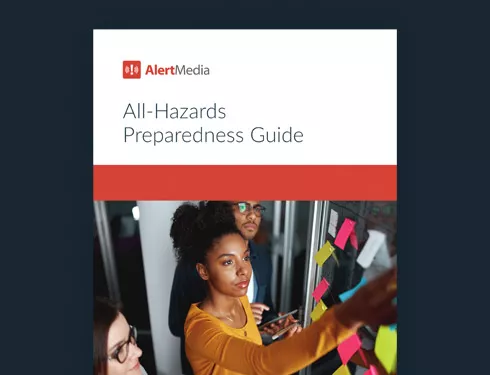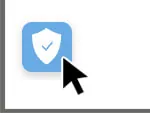
The All-Hazards Approach to Emergency Planning Explained
This post explores the all-hazards approach to emergency management, including how you can leverage it to protect your organization.

An emergency plan is one of your business’s most important safety assets. It prepares you for eventual threats and lays out how to ensure your employees’ safety and business continuity.
But not all emergencies look the same. So, the best emergency management plan can fall short if you’re facing a new or unprecedented situation.
On The Employee Safety Podcast, we spoke with Boeing’s Enterprise Emergency Preparedness Program Manager, Keith Berthiaume. Managing a huge global footprint, Keith’s team uses the all-hazards approach to ensure the company is prepared to respond to diverse emergencies impacting its locations, employees, and customers in every state and more than 70 countries.

Keith described how his team takes this approach to emergency management and business continuity: “We look at not what caused an incident but what are the impacts—to our building, our infrastructure, our supply chain, and our most important asset, which is our employees…
“We look at our business and ask these questions: What would happen if you didn’t have access to your entire team? Or if the application you relied upon so much is no longer there? What would happen if the buildings your teams work in are no longer habitable? Or if you could not receive a certain part from a supplier on schedule? We then build detailed preparedness and recovery plans to hopefully allow us to pivot and recover the business quickly.”
All-hazards preparedness is like resilience conditioning. Without the prep and practice, how will your team be ready to adapt during a crisis?
We’re going to walk you through risk analysis, response planning, and training for all hazards without having to make a unique plan for every possible risk.
You can download our All-Hazards Preparedness Guide to kickstart this process.
 Preview of AlertMedia's All-Hazards Preparedness Guide
Preview of AlertMedia's All-Hazards Preparedness GuideDownload Our All-Hazards Preparedness Guide
What Is the All-Hazards Approach?
The all-hazards approach is a comprehensive emergency preparedness framework that considers the full scope of emergencies or disasters when planning for response capacities and risk mitigation efforts. This means you are prepared for “all hazards” your business might face.
The all-hazards approach leads to a better overall emergency preparedness program than if you focus on just the most common or impactful critical events. You’ll have a more resilient business that can withstand disasters of all kinds.
Take the COVID-19 pandemic, for example. So many businesses were unprepared, and upwards of 20% of small businesses in the U.S. closed in the first two years of the pandemic. Even if they had an emergency plan for events like inclement weather or a workplace fire, an infectious disease outbreak of that caliber had likely not been planned for.
This global disaster revealed how far and wide a disaster’s impacts can spread. From strained healthcare systems to supply-chain disruptions and resource shortages to an abruptly distributed workforce and employees and families battling COVID-19 infections—the impacts shine a light on how businesses could have been better prepared, even without knowing what disaster to expect.
Pros and Cons of the All-Hazards Approach to Emergency Management
One common misconception is that all-hazards planning means planning for everything that can go wrong with a corresponding catalog of minute details. But that’s not it. Instead, all-hazards planning focuses on developing capacities and capabilities that matter when the going gets tough. You should ensure your business has the training, supplies, and leadership to address a broad range of emergencies rather than trying to plan every step for every specific hazard.
The benefits of an all-hazards plan
The primary benefit of the all-hazards approach is that it prepares your people and emergency resources to be flexible so they can work through any hazard. But there are a few other pros to this strategy:
- Makes your emergency preparedness more effective and scalable
- Turns seemingly monumental tasks into clear, executable plans
- Ensures employees have a standard protocol to follow
- Minimizes injury to people and destruction of business property
Limitations of an all-hazards plan
Because not all emergencies are alike, an all-hazards plan does have limitations. Something like a power outage will need much less management than a natural disaster that destroys an entire building. The response planning and preparation are very different for these two emergencies.
But remember, the goal of all-hazards planning isn’t to plan the exact response for every emergency. It’s to make sure you have a foundation of a plan during any crisis. These plans should be flexible and scalable for all possible emergency events.
“Having senior leaders all together on a team is a significant force multiplier because the executives at the highest level of the company are able to ensure implementation of integrated and coordinated response, seamless coordination, and a unified direction from the leadership team.”Keith Berthiaume Enterprise Emergency Preparedness Program Manager, Boeing
Develop Your All-Hazards Emergency Plan
Planning for every kind of emergency is not as time-consuming as you might assume. You can have a comprehensive all-hazards emergency response plan for your business in just a few steps. You can also find more resources at Ready.gov on emergency planning for private sector businesses.
Before you begin your all-hazards planning, gather all relevant stakeholders. An effective risk analysis leads to a thorough understanding of all the different types of hazards you might face. Mobilize anyone who could be helpful in creating a plan or has significant sway in business decision-making. Then you can move forward with the planning process.
1. Identify and assess threats
The first step is identifying all potential hazards and their impacts with a business threat assessment. Of course, risks and impacts will vary from location to location and company to company, but here are the most common events that require activation of an emergency plan:

- IT outages
- Inclement weather
- Power outages
- Natural disasters
- Man-made disasters
- Onsite fires
- Wildfires
- Facility management incidents
- Security-related issues
- Workplace violence
- Workplace safety incidents
- Public health emergencies
- Cybersecurity incidents
- Travel disruptions
- Public demonstrations/riots
When you scan this list, consider events that could occur at your facilities, plants, or offices. But be sure to discuss your risk assessment with all your stakeholders since they may know of risks you didn’t consider. No matter how many situations you must cover, an all-hazards plan is scalable enough to support any emergency response.
2. Build an action plan for emergencies
Once you have your list of potential hazards and impacts, determine the specific action steps necessary before an emergency, during the crisis, and in the disaster recovery afterward.
Remember, these don’t need to be down-to-the-letter specific to every single hazard. But think about the actions that are consistent among the different categories of emergencies, and write down your action plan. Here are a few examples of what that might include.
- Name people responsible for executing the emergency plan
- Create a list of supplies, maintenance, and equipment needed to keep operations going
- Hold employee training classes about emergency plans
- Stock first aid kits and disaster supply kits
- Contact local emergency responders, law enforcement, or aid at local levels as well as national providers like FEMA (Federal Emergency Management Agency)
- Identify communication procedures, and let employees know about emergency situations
- Follow any contingency planning if the situation changes
You can build these action plans into checklists that make it easy to work through the steps at any stage of a crisis.
3. Train and iterate
Training your team on the action plans is a great way to improve your hazard preparedness and increase the likelihood that your plans will be executed quickly, efficiently, and safely.
Tabletop exercises
Training strategies such as tabletop exercises are good for “dry runs” with low stakes. This gives your employees an idea of what might actually happen in an emergency, and it helps build muscle memory so necessary actions still happen even when tensions are high.
Drills and practice runs
When you want to get a little more tactical, you can run drills for specific situations, such as fire drills and evacuation plans in general, shelter-in-place/active shooter drills, and other full-scale emergency drills. These will allow your employees and safety leaders to practice what they learned during the emergency preparedness planning.
Situational awareness training
You can also conduct situational awareness training so your employees are more aware of their surroundings. Better observation skills can be a huge boost to the overall safety of a business.
Iterate and adapt
It is imperative that you don’t let your plans stagnate. Your risks, and your best responses, are likely to change with your business. You also may find that your plans didn’t accurately reflect what should be done. Use after-action reports to get an idea of how you can improve and iterate your plans.
4. Optimize communication
One of the most important features of any emergency planning is to make sure the business has a water-tight communication plan. Communication is the key to safety and efficient response in every emergency situation since your risk management can’t function if you aren’t able to reach your response team or employees to inform them of the risk.
A modern mass communication system is the best way to strengthen your communication readiness for any hazardous situation. Gone are the days of walkie-talkies, phone trees, and loudspeaker announcements. Today’s workforce is geographically dispersed, with remote workers, traveling employees, and countless others working away from their desks. So you need a reliable way to reach everyone when an emergency strikes.
Technology Solutions for All Hazards
Supportive technology is one of the best investments you can make for your all-hazards planning. The right technology makes planning and execution much easier, so you can ensure your organization’s safety, security, and resilience.
An alert notification system enables quick and reliable communication around these events, and you’ll have a secure place to store contact records and communication templates to save time and frustration during critical moments. You can also use a threat intelligence solution to better understand what hazards you face. With live alerts from verified sources and the ability to look through historic threats and chat with expert analysts, you’ll have the complete picture of your business’s threat landscape.
Then, you’re ready to plan ahead with the all-hazards approach, the most effective way to ensure you’re ready to face whatever hazards come your way. Hopefully, you never need to activate your emergency plan, but if you do, your business will be as ready as it can possibly be.

![6 Steps to Creating an Effective Emergency Response Plan [+ Template]](https://www.alertmedia.com/wp-content/uploads/2023/10/Blog-Emergency-Response-Plan.webp)


